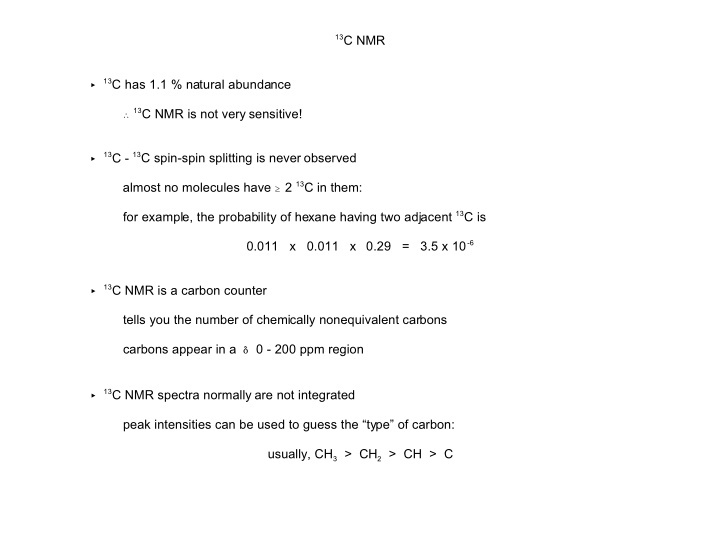



13 C NMR � 13 C has 1.1 % natural abundance � 13 C NMR is not very sensitive! � 13 C - 13 C spin-spin splitting is never observed almost no molecules have � 2 13 C in them: for example, the probability of hexane having two adjacent 13 C is 0.011 x 0.011 x 0.29 = 3.5 x 10 -6 � 13 C NMR is a carbon counter tells you the number of chemically nonequivalent carbons carbons appear in a � 0 - 200 ppm region � 13 C NMR spectra normally are not integrated peak intensities can be used to guess the “type” of carbon: usually, CH 3 > CH 2 > CH > C
� DEPT 13 C NMR spectrum tells you the number of chemically nonequivalent CH 3 , CH 2 , and CH carbons C do not appear–they must be identifed by comparison with the normal 13 C NMR spectrum ways to present a DEPT 13 C NMR spectrum: Q ( 13 C NMR spectrum) + (DEPT-90) + (DEPT-135) (all carbons) + (only CH carbons) + (CH and CH 3 carbons up, CH 2 carbons down) this is the textbook’s method Q ( 13 C NMR spectrum) + (CH 3 subspectrum) + (CH 2 subspectrum) + (CH subspectrum) + (all protonated carbons subspectrum) Q 13 C NMR spectrum with CH 3 , CH 2 , CH , and C resonances labeled
13 C NMR methanol
13 C NMR ethanol
13 C NMR ethyl acetate
BASIC 13 C NMR CHEMICAL SHIFTS C Type Approximate � , ppm Alkanes Methyl 0 - 30 Methylene 15 - 55 Methine 25 - 55 Quaternary 30 - 40 Alkenes C= C 80 - 145 Alkynes C � C 70 - 90 Arenes 110 - 170 Benzene 128.7 Alcohols and Ethers C–O 50 - 90 Amines C–N 40 - 60 Halogens C–F 70 - 80 C–Cl 25 - 50 C–Br 10 - 40 C–I -20 - 10 Carbonyls R 2 C= O 190 - 220 RXC= O (X = O or N) 150 - 180
13 C NMR of a tribromobenzene, C 6 H 3 Br 3 What’s the structural formula?
13 C NMR of 1,3,5-tribromobenzene
13 C NMR spectrum of a chloropentane
Use of DEPT 13 C NMR to identify chloropentane structural isomers A C 5 H 11 Cl
Use of DEPT 13 C NMR to identify chloropentane structural isomers CH 2 CH 2 CH 2 CH 3 CH 2 A C 5 H 11 Cl
Use of DEPT 13 C NMR to identify chloropentane structural isomers CH 2 CH CH 3 CH 2 CH 3 B C 5 H 11 Cl
Use of DEPT 13 C NMR to identify chloropentane structural isomers CH 2 CH 2 CH 3 CH 3 C C 5 H 11 Cl CH
Use of DEPT 13 C NMR to identify chloropentane structural isomers CH 3 CH 2 D C 5 H 11 Cl CH 3 C
Use of DEPT 13 C NMR to identify chloropentane structural isomers CH 3 E C 5 H 11 Cl CH 2 C
Recommend
More recommend